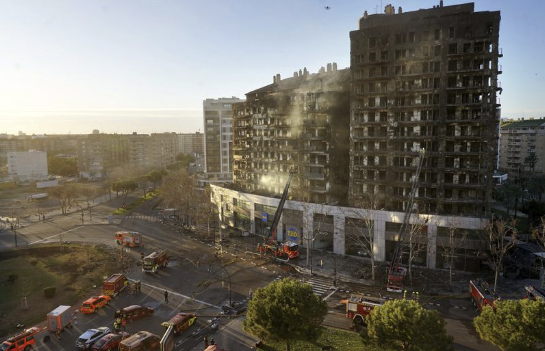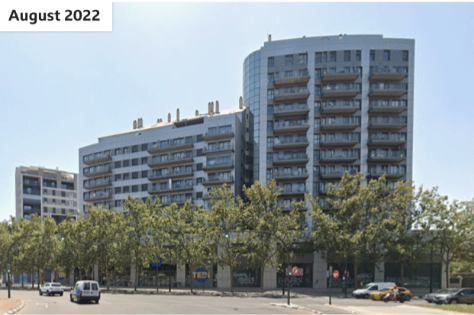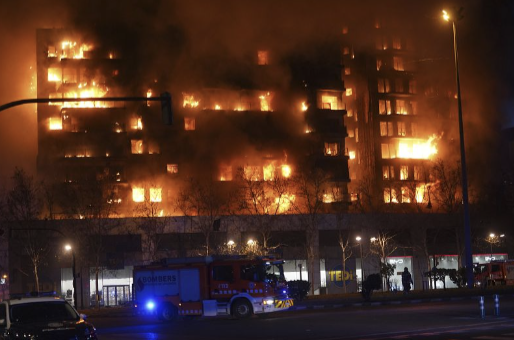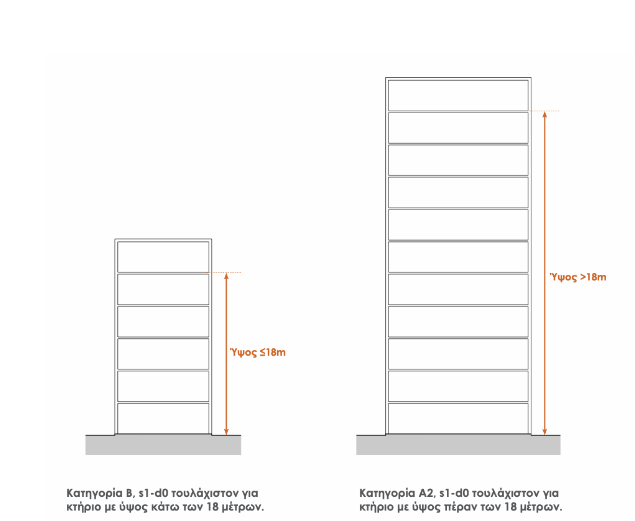By Dr Klelia Petrou, Fire Safety Engineer/Senior Research Fellow at CERIDES – Excellence in Innovation and Technology, European University Cyprus
The recent residential building fire in Valencia, Spain, which claimed the lives of at least 10 people, reignited concerns about the use of combustible facade systems in buildings.
While the investigation into the fire’s cause is ongoing, the tragic event serves as a stark reminder of the potential dangers posed by these materials.

Figure 1 – Firefigthers work at a burned block building in Valencia.Source Euronews – Alberto Saliz/Copyright 2024 The AP. All rights reserved.
Combustible facade systems are exterior wall coverings composed of materials that can easily burn, such as aluminum composite panels (ACP) with polyethylene cores for cladding and combustible insulation on wooden or metallic frames. These systems are often used for aesthetic and thermal-insulation purposes and offer advantages like lightweight construction and ease of installation. However, their flammability raises significant fire safety concerns.

Figure 2 – The residentail building before the fire. Source BBC.com
While details are still emerging, the Valencia fire reportedly spread rapidly upwards, downwards and side-wise, highlighting the contribution of the combustible facades system onto the fire spread in just minutes. This resulted in trapped occupants rescued by the firefighiters, posed significant risk to the safety of the firefighters and caused total building damage. Similar incidents in recent years, such as the Grenfell Tower fire in London, which claimed 72 lives, have further amplified the issue. To emphasize the danger, it should be noted that fire spread in Grenfell was so fast that it took approximately 12 minutes for the fire to spread 19 storeys upwards.

Figure 3 -The residential building engulfed in flames. Source Euronews (https://www.euronews.com/2024/02/23/as-many-as-15-people-still-missing-after-valencia-apartment-building-fire)-Credits AP Photo/Alberto Saiz

Figure 4 – Flaming debris falling around the firefighters during their firefighting extinguishing operations.
The use of combustible facade systems is a complex issue with various stakeholders involved. Architects and developers often favor these materials for their design flexibility and cost-effectiveness. However, building safety regulations and public awareness are evolving to prioritize fire safety. In the wake of the devastating Grenfell Tower fire in London, the European Union and the United Kingdom have undertaken a comprehensive review of their respective building regulations. This review aims to implement stricter building codes that restrict or outright ban the use of combustible materials in high-rise and high-risk buildings.

Figure 5 – Grenfell Tower fire, London, June 2021.Source BBC.com
In the Republic of Cyprus, national building regulations mandate the use of non-flammable materials in facade systems for tall buildings since 2017. As stipulated in Annex IV-Fire Protection, Roads and Buildings Law-regulation 61IA, Ministry of Interior, Cyprus (Παράρτημα IV- Πυροπροστασία of Οδών και Οικοδομών Νόμου-κανονισμός 61ΙΑ, adhering to European classifications (EN13501-1) for building material reaction to fire new structures below 18 meters must employ materials with limited combustibility (B-s1-d0) or better. For structures exceeding 18 meters, exclusively non-combustible materials (A2-s1-d0 or A1) are permitted. It is crucial to note that these regulations are currently under review at the European level, with potential for stricter implementation in the future.

Figure 6 -Façade systems reaction to fire requirements in accordance with Παράρτημα IV-Πυροπροστασία of Οδών και Οικοδομών Νόμου-κανονισμός 61ΙΑ- Source Marios Michaelides Chartered Architect RIBA- Makis Michaelides + Associates
Chartered Architects
While these measures safeguard new construction, the tragic incidents at Grenfell Tower and the Valencia residential building underscore the urgent need for proactive action regarding existing buildings with combustible cladding systems. A comprehensive national strategy is essential to evaluate these systems across Cyprus existing building stock. This strategy should mandate the replacement of non-compliant facade systems, prioritizing public safety and preventing future tragedies.
In conclusion, the Valencia fire serves as a stark reminder that ensuring building safety requires a multifaceted approach. While implementing stricter regulations and conducting thorough evaluations of existing structures are crucial steps, a sustainable solution lies in fostering innovation and public awareness. Encouraging the development of more non- combustible or fire-resistant materials for facade systems will represent a significant shift towards safer construction practices. Simultaneously, raising public awareness about the risks associated with combustible facades and the importance of fire safety regulations empowers individuals to advocate for safer communities. By embracing these combined efforts, we can move towards a future where buildings are not only aesthetically pleasing and thermal-insulated, but also prioritize the well-being of their occupants, creating a more resilient and fire-safe built environment for all.
References
[1] Euronews online, “At least 10 people dead in Valencia high-rice building fire”, February
2024, https://www.euronews.com/2024/02/23/as-many-as-15-people-still-missing-after-valencia-apartment-building-fire
[2] BBC.com, “At least five killed as blaze engulfs apartment blocks in Spain Valencia”,
February 2024, https://www.bbc.com/news/world-europe-68374811
[3] MailOnline, “Chilling comparisons between Valencia blaze and Grenfel disaster as
cladding is vlamed again for Spanish tower block fire”
https://www.dailymail.co.uk/news/article-13116763/valencia-blaze-grenfell-tower-disaster-fire.html
[4] Annex IV-Fire Protection, Roads and Buildings Law-regulation 61IA,
Ministry of Interior, Cyprus. Παράρτημα IV-Πυροπροστασία, Οδών και Οικοδομών Νόμου-κανονισμός 61ΙΑ,
Υπουργείο Εσωτερικών, Κύπρος.
[5] EN 13501-1 Fire Classification of construction products and building elements-Part 1:
Classification using data from reaction to fire tests.

